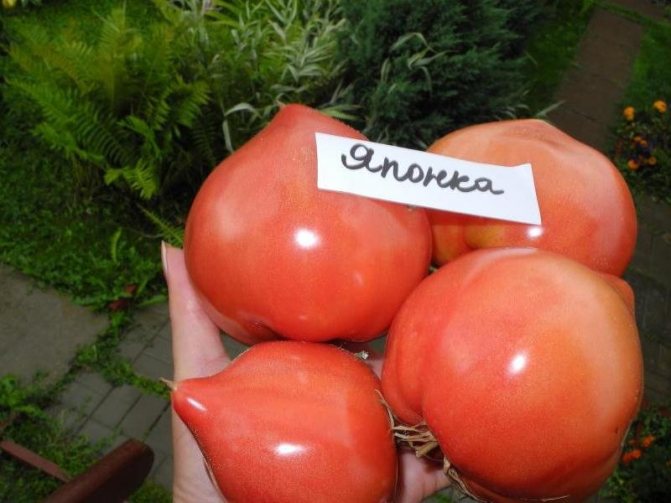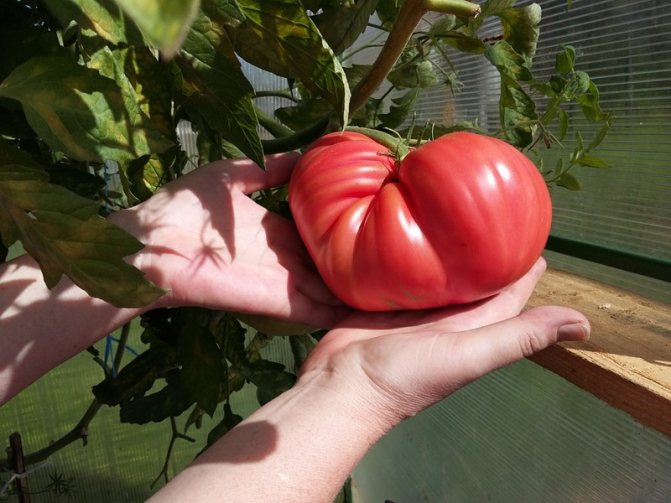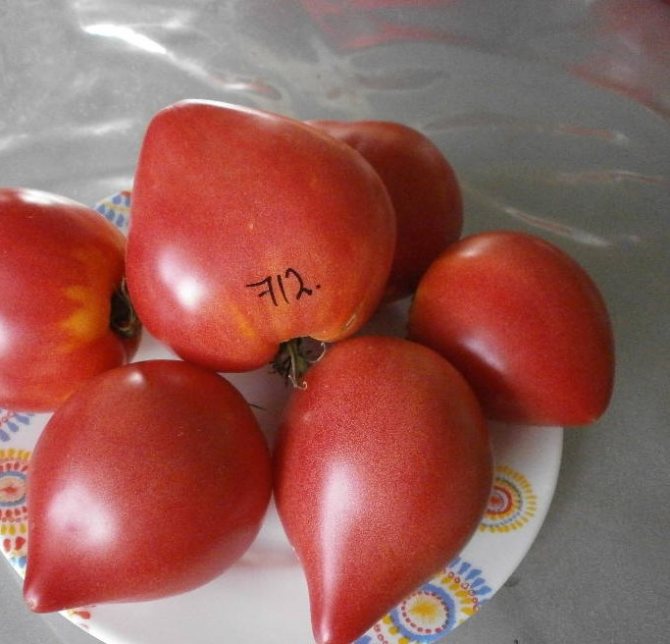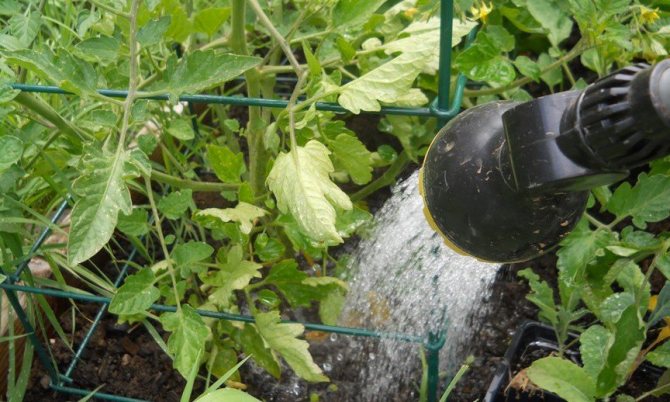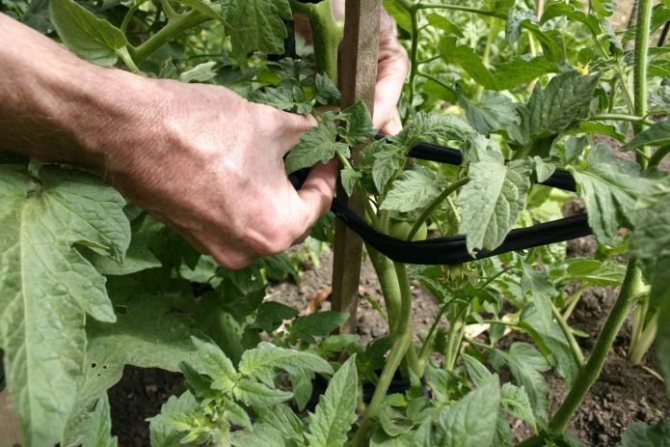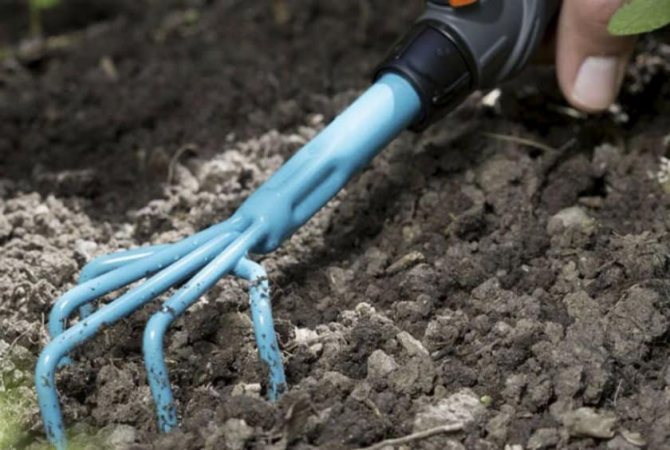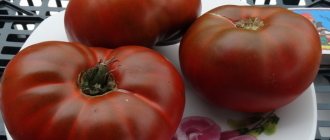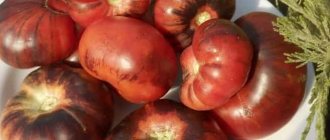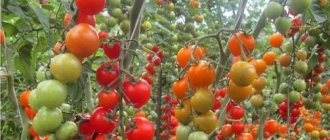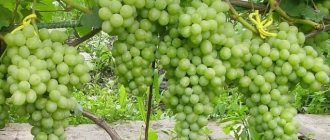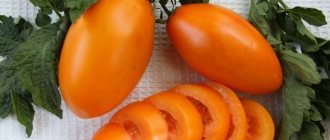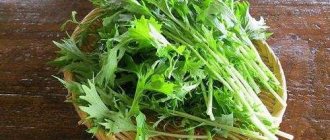The Japanese tomato is not produced by any of the well-known companies, but nevertheless it is well known to tomato lovers. The seeds are bought from collectors to grow a stunningly tasty harvest of beautiful large fruits.
| Height | Pick-up location | Ripening terms | Fruit color | Fruit size | Origin | Fruit shape |
| Medium-sized | Greenhouse | Mid-season | Red | Large | Variety | Heart-shaped |
General description of the variety
The Japanese brush tomato is a small and delicate cherry tomato. The variety was bred by Japanese breeders. It appeared on the Russian market relatively recently.
The bushes of this variety are characterized by constant growth. They belong to indeterminate cultures and reach a height of two meters.
The Japanese brush is grown both in the greenhouse and in the open field. In the northern regions, experienced gardeners note that the highest yield is achieved precisely when grown in greenhouses and greenhouses.
The variety needs pruning and pinching. Otherwise, it is unpretentious.
Note! The Japanese brush tomato can also be grown on the balcony. In this case, the harvest will not be as plentiful, but the fruits will remain as tasty.
Distinctive features of the Japanese brush
Japanese brush is small red fruits weighing up to 60 g... The fruits have a juicy pulp and a sweet, slightly sour taste. The meatiness of the tomatoes is average. They contain a lot of juicy small seeds.
The fruits of the Japanese brush are used mainly for cooking hot dishes and preservation. They can also be consumed raw.
The main distinguishing feature of the Japanese brush is its resistance to a number of plant diseases. This makes it easier to care for him.
High yield is another feature of the crop. With proper care, more than a hundred small fruits can be harvested from one bush.
Characteristics
Despite the fact that the cherry tomato Japanese brush only recently appeared on the markets of our country, it has already begun to rapidly gain popularity. This is due to its excellent characteristics.
Description of the Japanese brush:
| Parameter | Indicators |
| Bush type | Indeterminate. Grows up to 2 meters in height. They have light green green and an average number of leaves. The stems are dense. |
| Growing method | Suitable for outdoor and greenhouse cultivation. The first method is mainly grown in warm regions with long summers. |
| Yield | High. More than 100 fruits can be harvested from one bush per season. |
| Fruit | Red inside and outside. They have a dense skin and juicy flesh. Small, weighing from 30 to 60 g. Medium meaty with sweet and sour spicy taste. |
| Transportability | High. The fruits have a strong skin, so they do not crack during transportation. Can be stored for more than 2 weeks. |
| Ripening terms | Mid-season variety. The fruits ripen by the middle of summer. In the greenhouse, fruiting continues until the end of autumn. In open ground - until the first frost. |
| Disease resistance | Tobacco mosaic, top and root rot. |
Brief information about the variety
- Bush: plant of indeterminate type, reaches 1.8-2 m in height, therefore it needs a garter and shaping.
- Fruit: large tomatoes reach 300-400 g in weight, the surface is pink-raspberry.
- Yield: If you follow all the rules of agricultural technology, you can get up to 11 kg of delicious tomatoes from 1 m².
- Sustainability: good immunity to sudden changes in temperature.
- Spread: in the south (in the Krasnodar Territory, the Astrakhan Region and the Kuban), it is cultivated in the open field. In the Central (Kursk, Belgorod region), Moscow region, Leningrad region, in the North, the Urals and Siberia, it is cultivated in polycarbonate greenhouses or hotbeds.
- Application: Tomatoes are used in salads, ketchup, lecho, juices and cold snacks. The sweet and aromatic pulp of the fruit is used for making sauces and pasta. Some hostesses roll up vegetables in chunks.
- Landing: seeds for seedlings. Scheme - 3x5 cm.
- The soil: light, drained, flavored with organic matter and mineral components.
- Care: feeding, watering, loosening, garter and shaping in 1-2 stems.
- Fruiting period: mid-season plant - the first fruits begin to bear in late summer or early autumn. Long-term fruiting - lasts until late autumn (mid-October or early November).
Growing seedlings
In our country, in open ground or soil, the culture is planted in a germinated and formed form. Planting material is planted in late February - early March. When choosing the time of sowing seeds, be guided by the lunar calendar.
Preparing the seeds
Seed preparation is an important step in growing seedlings. If done correctly, you will grow healthy plants and have excellent germination rates.
Seed preparation for sowing:
- Before purchasing seeds, make sure that they are not expired. This step can be omitted when using seeds from a previous crop.
- Pick up the planting material. Remove all damaged, black and moldy seeds.
- The seeds are soaked overnight in a light pink solution of potassium permanganate. The floating seeds are removed, they will not germinate. You can treat the seeds by soaking them for 3 hours in a weak solution of hydrogen peroxide.
- The seeds are treated with a growth promoter. To do this, they are soaked for one more night in a special solution ("Epin", "Zircon" or humate, diluted in a ratio of 1: 100) or in water. To do this, they are placed in gauze soaked in a special composition until germination.
A few words about capacity and soil
The choice of capacity is another important stage in preparation for growing seedlings. Different containers are used for sowing seeds.
First, all seeds are sown in one container. Therefore, the first container must be large. For these purposes, special plastic trays or wooden boxes are suitable. You can make containers from scrap materials.
When the plants germinate, they are transplanted into individual pots. For these purposes, use small peat containers or plastic cups.
The soil is sold in a specialized store. The soil mixture can be prepared independently by mixing peat and turf soil with humus in equal proportions.
Both purchased and homemade soil must be processed. To do this, it is watered with a light pink solution of potassium permanganate or ignited in an oven at a temperature of 100 degrees.
We sow planting material
Planting material is sown into the soil, deepening them by 1 cm. For this, grooves of the appropriate depth are made in the ground. Seeds are poured into them at a distance of 0.5-1 cm from each other.
Seedling boxes are placed on the windowsill. They are preliminarily covered with foil. The optimum temperature for seed germination is 25 degrees.
Airing the seeds will prevent moisture from stagnating. In a warm time of the day, the film is regularly opened for 2 hours.
Advice! It is not necessary to place the seedlings on the windowsill. If you have a dedicated UV lamp, the seed boxes can be placed anywhere in the room.
How to grow
Japanese tomato requires growing seedlings.By the time of disembarkation, she should be 2 months old. Those who have already planted this tomato recommend sowing it at the end of February. If we take into account the time required to wait for seedlings, for the development of Japanese tomato seedlings, March and April will remain. In the greenhouse, the soil warms up faster than on the street, by the beginning of May it will already be warm enough in it for the tomatoes to take root successfully.
Growing seedlings
If tomato seeds were bought from collectors, then all the seeds will have to be sown - after all, there are very few of them. As a rule, they have already been selected for size and quality, so one can hope for 100% germination. To help Japanese tomato seeds wake up, we will additionally treat them with a growth stimulant. Collectors usually don't get sick of tomatoes. The huge number of varieties does not allow planting many plants of the same variety, therefore each copy is valuable. The gardener is obliged to take care of the health of tomatoes, and carries out all preventive treatments for diseases.
A warning! It is better to pickle the seeds so as not to bring diseases with planting material into your greenhouse.
There are many different ways to do this. It is for tomatoes that the best option is to soak in aloe juice. In addition to possessing pronounced bactericidal properties, this miraculous plant is a powerful biostimulant for both humans and plants.
In order for the juice to maximize its beneficial properties, aloe must be properly prepared. To obtain juice, leaves of a flower older than three years old, which have not been watered for 2 weeks, are suitable.
Advice! Aloe is a very hardy plant and will not suffer from lack of moisture during such a period, but it will accumulate more biologically active substances.
To prepare the juice, the lower completely healthy leaves are cut off. They are wrapped in a dark cloth and kept on the bottom shelf of the refrigerator for a week or two. Then the leaves are ground in any convenient way and the resulting gruel is filtered and squeezed, if possible.
Attention! For fresh seeds, the juice must be diluted with water twice, if there is a suspicion that the seeds are old, it can be left alone.
Soaking is carried out for 18 hours, completely immersing the seeds in the juice. It is better to do this in a bag of gauze or thin cotton cloth. After soaking, the seeds are not washed, but immediately sown or germinated on damp cotton wipes, putting on a plastic bag.
Next steps:
- we sow tomatoes in loose, slightly moistened soil to a depth of 2 cm, you can sow them in one container, but it is better to settle each seed in a separate small pot;
- We spread a layer of snow 2 cm thick on top, usually there is a lot of it in February. The melted snow will saturate the soil with melt water, which stimulates the rapid germination of seeds and has a beneficial effect on future plants.
- it remains only to put plastic bags on containers with Japanese tomato seeds and put them in a warm place;
- seedlings will appear quickly - on day 4 or 5, they really need the maximum amount of light, otherwise thin sprouts will stretch out before our eyes, they do not need a lot of heat at this stage of development, it is enough to maintain a temperature of about 16 degrees in the daytime and 14 degrees at night ;
- in about a week, the Japanese tomato seedlings will get stronger, grow roots and she will need a different temperature regime: 22-23 degrees during the day and 18 at night;
- water the tomatoes, soaking all the soil in the pots, but only when it dries up. Excessive moisture harms tomatoes - it provokes a black leg disease, in this case it will be difficult to save the seedlings.
- tomatoes of the Japonka variety, planted in separate pots, do not need a pick, they will need to be transplanted into pots or glasses with a volume of at least 700 ml, and preferably 1 liter, keeping an earthen lump with roots; do this when Japanese tomatoes have 4 or 5 true leaves;
- in order for Japanese tomato seedlings to grow of high quality, she needs sufficient nutrition: 2 or 3 additional feeding with a weak solution of a mineral complex fertilizer with a frequency of 2 weeks; you need to feed the plants starting from the formation of the first true leaf, at this time the nutrients contained in the seed run out and the Japanese tomato plants need recharge from the outside;
- an important event is the hardening of seedlings; of course, the conditions for plants in the greenhouse are more comfortable than outside, but they differ from those in the room, so that the plants do not experience stress when they change abruptly, we accustom them to them gradually, this will take 2 weeks.
The nuances of caring for seedlings
It is important to properly care for the seedlings. Only in this case can you get healthy and strong plants that will give a bountiful harvest.
Seedling care rules:
- The first watering of seedlings is done a week after planting. It is sprayed from a spray bottle with settled water at room temperature. In the future, watered as the soil dries.
- Make sure that the plants do not freeze. The film can be removed after all the seeds have germinated.
- After the appearance of real leaves on the plants, the sprouts dive into individual pots. It is important to do this carefully so as not to damage the formed roots.
- After transplanting seedlings, it is watered with a small amount of water. After 5-7 days, the plants are fed with complex fertilizers.
- Two weeks before planting the plants, you need to start hardening the seedlings. To do this, the pots are taken out into the greenhouse, on the street or on the balcony. The first time hardening lasts an hour, then the time is increased by another hour. So gradually, the time the plants stay on the street increases to a whole day.
Diseases and pests
One of the benefits of the plant is that it is resistant to major diseases. However, the tomato can become infected from other plants, in order to prevent the development of brown or gray rot, which destroy tomatoes and plants, or spider mites, which dries the tomato, certain precautions must be taken.
Prophylaxis
The description says that the vegetable grower does not need to perform any complex manipulations. The most important thing is that the precautions taken are taken on time and clearly according to the rules. The whole process consists of the following points:
- An excellent solution would be when the gardener conducts land turnover. That is, it is not recommended to plant tomatoes in a place where there were previously potatoes, eggplants or peppers. It is good if the predecessors were: carrots, cabbage or legumes.
- If the place of cultivation is a greenhouse, then every season the top layer of the soil is changed, in addition to this, spilling it with a solution of copper sulfate or potassium permanganate (potassium permanganate).
- Greenhouses must be ventilated and weeds must be removed.
- An excellent prophylactic agent will be phytospores and a weak solution of potassium permanganate, they are sprayed on young bushes.
- The fight against insects has been carried out literally from the first days. To do this, the soil must be warmed up in the oven, the temperature is 60-65 ° C, not lower, only in this way the larvae will be destroyed.
- Once a week, an examination is carried out for the appearance of diseases, if there are any, the plant must be destroyed so that the virus or fungus does not spread to other bushes.
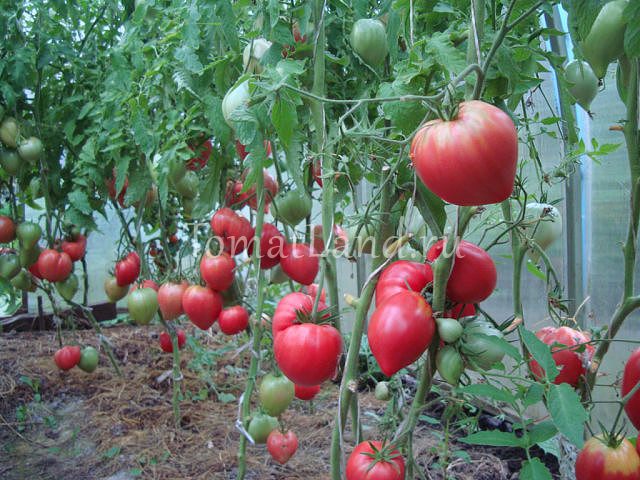
photo by Tatiana Fedorenko
Growing tomatoes
When the soil warms up enough, the tomatoes are planted in the ground. This is usually done in early or mid June.
The Japanese bunch is grown outdoors or in greenhouses. For regions with a cold climate, the second option is more suitable.


Planting seedlings in the ground
Tomatoes are planted either in mid to late May or early to mid June. It depends on the climate of the region in which you live. The Japanese bunch is a variety that is not highly resistant to temperature extremes. Therefore, night frosts can cause the death of immature plants.
One sq. m 3-4 tomato bushes are planted. Planting culture - 30/50 cm.
Ash and compost are poured into the holes in which the tomatoes will be planted. They are also abundantly watered with warm water.
The seedlings are deepened to the first lower leaves. To form additional roots, elongated plants can be planted to a depth of 2-3 leaves.
The first time the tomatoes are watered 10 days after transplanting the seedlings to a permanent place. During this time, tomatoes will have time to adapt to new conditions. At the same time, feeding is also done.
Care
The Japanese brush is a cultivar with constant growth. Therefore, he needs a garter and shaping. They form a bush into two stems, this increases the yield.
Pinching is carried out regularly. When pinching, the lower shoots and leaves are removed. It is necessary to remove all withered and damaged greens. Such manipulations are performed no more than once a week. On the day of pinching, you do not need to water.
Tomatoes are watered once a week. In hot weather, this can be done more often - 2-3 times a week.
Tomato bushes Japanese brush need a mandatory garter. For this, special supports are used, for example, wooden planks.
It is important to feed your tomatoes regularly. This will increase their yield and speed up the fruit setting process.
Top dressing of tomatoes:
- Mineral fertilizers. They are introduced 2-3 weeks after the tomatoes are planted in the ground. The first top dressing includes superphosphate and potassium sulfate (20 and 15 g per 1 sq. M). The second and third feeding is done at the stage of fruit formation. To do this, 1 sq. m is used 15 g of ammonium nitrate and 20 g of potassium sulfate.
- You can feed the plants with organic fertilizers... To do this, use a solution of manure fermented with weeds. A mixture of 1 bucket of weeds, 1 bucket of manure and 100 liters of water is prepared. When the mixture is fermented, it is diluted 1:10.
- Boric acid is used for foliar dressing.
Growing tips
To get a good harvest, you need to know some of the intricacies of growing tomatoes. The most important ones are presented below.
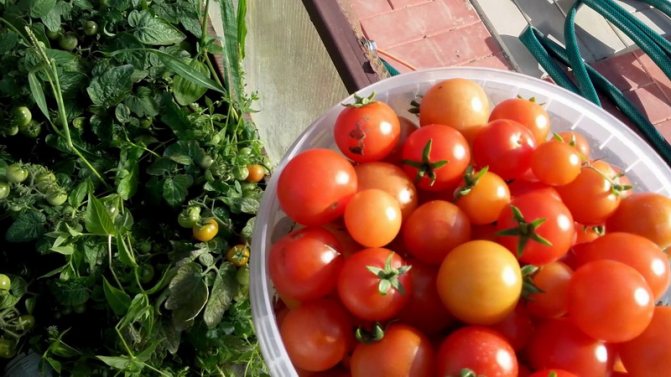

Tips for growing tomatoes:
- It is better to tie up heavy tassels with a lot of small fruits to the support. Otherwise, the stalk may break.
- Water the plants only "at the root". This will reduce the likelihood of their being affected by plant diseases.
- Mineral and organic fertilizers are introduced in the form of irrigation. It is important not to get the composition on the greens and the stem of the plant.
- Regular loosening of the soil is necessary for the full growth of tomatoes.
Diseases and pests
Tomato Japanese brush is resistant to apical and root rot and tobacco mosaic. The gardener will have to fight the rest of the plant diseases.
Pests are collected from tomatoes by hand. There are chemical agents that prevent their appearance, but gardeners advise not to use them to get a better and healthier crop.
Careful weeding of the beds will save the plants from the bear. For the same purposes, in the autumn, when preparing the beds, eggshells are poured into the soil.
For late blight, Bordeaux mixture is used. You can also use special preparations, for example, "Polyazophos" or "Ditan".
Brown spot can be fought with Fundazol. When signs of powdery mildew appear, spraying with Bayleton is performed.
general characteristics
Tomato variety Japanese crab of an indeterminate type, the bush reaches 1.8-2 m in height, therefore it needs a garter and shaping.
The characteristic of the bush includes the following features:
- the stem is massive, thick, green, without pubescence;
- leaves are dense, corrugated, of medium size, elongated with a small section along the edges;
- inflorescences are simple;
- 6-7 flower clusters are formed on one bush, each with 5-6 fruits.
If you follow all the rules of agricultural technology from 1 m², you can get up to 11 kg of delicious tomatoes.
The plant is mid-season - the first fruits begin to bear in late summer or early autumn. Long-term fruiting - lasts until late autumn (mid-October or early November).
Spread
The culture is popular throughout our country:
- in the south (in the Krasnodar Territory, the Astrakhan Region and the Kuban), it is cultivated in the open field;
- in the Central (Kursk, Belgorod regions), the Moscow region, the Leningrad region, in the North, the Urals and Siberia, they are cultivated in polycarbonate greenhouses or hotbeds.
Description of fruits
Japanese crab tomatoes are very attractive in appearance and deserve the attention of both experienced and novice gardeners:
- large tomatoes reach 300-400 g in weight;
- the surface is not too thick, therefore, require careful handling after collection;
- at the stage of full ripening, the fruits acquire a pink tint;
- flat-round shape with lush shoulders and ribbing in the area of the stalk;
- the pulp is multi-chamber, juicy, fleshy, sweet.
The fruits are used in the preparation of salads, ketchup, lecho, juices and cold snacks. The sweet and aromatic pulp of the fruit is used for making sauces and pasta. Some hostesses roll up vegetables in chunks.
Differences between growing in a greenhouse and in an open field
The Japanese brush can be grown both outdoors and in greenhouses. At the same time, there are several differences in the care of tomatoes growing in a greenhouse and outdoors.
Seedlings are planted in the greenhouse earlier earlier by 1-2 months.
After transplanting seedlings into open ground, for the first two weeks, they are covered with a film for the night. This will prevent her death during the night cold snap.
When growing tomatoes in your garden, choose locations where the crop will not be exposed to the scorching sun. Better to plant tomatoes in partial shade.
You cannot plant tomatoes in the same place for two years in a row - regularly change the location of the tomato beds.
Remember to ventilate the greenhouse. To do this, in a hot time of the day, windows and doors are opened for several hours.
Transfer to the garden
Despite good resistance to sudden changes in temperature, young bushes require gradual accustoming to fresh air. Without hardening, planted tomatoes can burn in the sun, or freeze from the cold at night. Therefore, ten days before disembarkation, the seedlings are taken out daily in the street in the morning and kept for 1-1.5 hours. Gradually, the time spent in the fresh air is increased, and on the last day they are left to spend the night on the street under a film shelter.
The optimal time for transplanting to a garden bed is early or mid-May, in open ground - the second half of May.
Site preparation
When disembarking in an open bed, choose a sunny place where there is no stagnant water and strong winds. The best predecessors of this crop are legumes, cabbage, onions, garlic, cucumbers, dill and parsley.
The garden bed is prepared in the fall after harvesting:
- remove all weeds, plant residues;
- add a bucket of humus or compost, 3-4 kg of ash, a bucket of sand, 100 g of superphosphate and 80 g of potassium sulfate, add 300 g of slaked lime or chalk per 1 m² to the acidic soil;
- after that, the bed is dug up, leveled and watered.
In the spring, a couple of weeks before planting tomatoes, the soil must be disinfected - irrigated with a solution of carbamide - diluted in 10 liters of water 15 g of the substance. The liquid agent not only destroys pathogenic bacteria, but also increases the fertility of the soil.
():
As a disinfectant, urea (carbamide) is used in a more concentrated form - 3-5% solution. This is 300-500 g per 10 liters of water.
Landing scheme
An indeterminate plant requires a lot of space on the site, so it should be planted at a distance of 50 cm with a distance between rows - 65-70 cm. The optimal amount per 1 m² is 3-4 bushes.
Pits, dug to the size of the root system of the seedlings, are spilled abundantly with water, wait until moisture is absorbed, then planted. For stability, the bushes are spud with garden soil. A peg or trellis is placed near each plant for further support.
Harvesting and application of the crop
In the middle of summer, they begin to collect ripe fruits. This should be done regularly so that the plants are not affected by late blight.
Usually cherry tomatoes are picked with whole brushes. You need to wait until most of the fruits are ripe. For such varieties, this happens evenly.
You can also pick slightly unripe fruits. They will turn red at home too.
A few ripe tomatoes in the garden can be left to get new seeds. For this, pulp with seeds is chosen from them and soaked in water at room temperature for 2-3 days. After that, the planting material is dried and sent to storage in fabric bags or coffee filters.
Advantages and disadvantages of the "Japanese brush"
Japanese brush has many advantages:
- high productivity;
- long-term fruiting;
- great taste;
- good transportability;
- resistance to tobacco mosaic, apical and root rot;
- the possibility of growing in open and protected ground;
- versatility of the use of fruits.
There are few disadvantages of this variety. These include the need for a garter and pinching, instability to temperature extremes, and immunity to a small number of plant diseases.
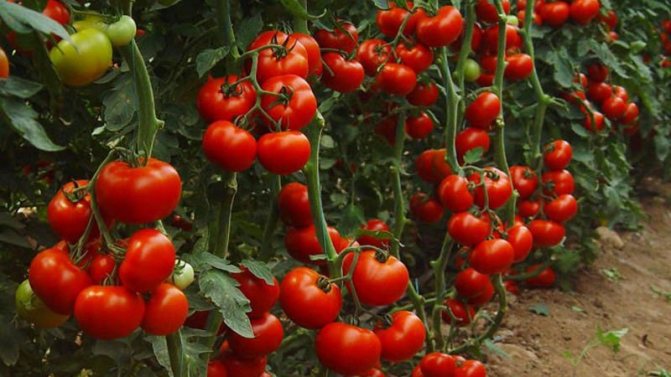

Farmers reviews
Many farmers love the Japanese brush tomato. Reviews of this variety are mostly positive.
Reviews of the tomato Japanese brush:
Vishnevskaya Victoria, Odessa “I have been growing cherry Japanese brush for two years in a greenhouse. I like the bountiful harvest and sweet and sour taste of tomatoes. Can be used for salads and preservation. Not capricious. There are no complaints ”.
Orlov Grigory, Tula " I have a tomato Japanese brush growing in the open field. Very nice little fruits. It is imperative to treat against late blight and other diseases. Tomatoes taste sweet and sour, it seems to me that they are more suitable for preservation. "
Scope of the fruit
Due to the sweet taste, the fruits of the Japanese tomato are classified as dessert varieties and are used mainly for preparing vegetable salads and snacks.
Although these tomatoes do not crack when cooked, they are too large and unsuitable for whole fruit canning. Usually sauces, juices and tomato paste for the winter are prepared from these fruits.
